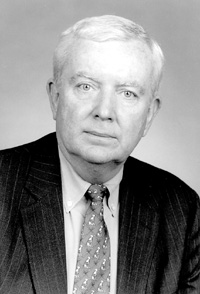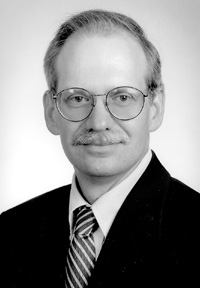
Robert K. Bickerton
Gregory E. Gardiner
Jonathan E. Soderstrom
|
of his predecessors in OCR
Jonathan E. Soderstrom has been named director of Yale's Office of Cooperative Research (OCR), where he plans to build on the strong foundation set by his predecessors and take OCR to the next level.
Soderstrom succeeds Gregory E. Gardiner, who has been director of OCR since February 1996. Gardiner is leaving to pursue other interests.
At the same time, Robert K. Bickerton, the first director of the OCR office when it was established in 1982, is retiring from his current position as special assistant to the provost.
All three have played an integral role in bringing the OCR to its present position.
The OCR evaluates the commercial potential of research and helps researchers apply for patents, negotiate licensing agreements and secure support from business. Since its inception, the office has negotiated about 250 invention license agreements and has helped establish about 40 new companies.
"This is a historic moment in the development of the Yale Office of Cooperative Research, with a retirement, a departure and a new appointment -- involving three truly outstanding leaders -- all happening at once," says Provost Alison Richard.
"As its first director, Robert Bickerton carefully nurtured OCR through its formative years with stunning achievements along the way. The imagination, energy, and drive of his successor, Gregory Gardiner, have propelled OCR to remarkable new heights in a very short period, and he has brought national and international attention to Yale's activities. We are fortunate indeed that Jon Soderstrom agreed to take over as director of OCR this September. The shoes he has to fill are very big indeed, but I am confident that Jon will find them a good fit."
The OCR was established at a time when there was concern about the lack of interaction between Yale and industry, says Bickerton, whose office in the beginning consisted of himself and one administrative assistant. The office now has 12 professional and support staff members.
"There was a need for internal and external marketing," Bickerton says. "There were meetings with leaders in industry to let them know Yale wished to interact with them. There were meetings with faculty to explain the benefits of interaction. Many of the faculty, at Yale and at other universities, were uneasy about interacting with industry. There was concern that the university would be 'eating its own seed corn,' as it was described at the time -- that top-notch researchers would find financial benefits working in industry, attracting them away from the University. My view was that faculty are faculty because they want to be faculty."
It can take many years for a research discovery to emerge as a marketable product or process. One project started under Bickerton's tenure was development of the drug Zerit, an HIV reverse transcriptase inhibitor that has prolonged the lives of hundreds of thousands of AIDS patients. "We licensed Zerit to Bristol-Myers Squibb in 1986 and it took 10 years to get it on the market," he says.
Zerit has been one of the top academic success stories for technology transfer nationwide and it continues to produce sizeable royalties for Yale. Another major licensing arrangement initiated under Bickerton's tenure was the Lyme disease vaccine discovered at Yale. The royalties to Yale and faculty are based on a formula that is similar to that used at other universities and are paid after the expenses of the OCR office are deducted.
Deputy Provost Charles Long says the OCR's projects cover a wider range than most people realize. Long, for instance, worked with Bickerton, WGBH-TV in Boston, Wellesley College and Yale University Press on "French in Action," a series of French language films developed primarily by Pierre Capretz, director of the Yale Language Laboratory. The films remain the most frequently broadcast programs on public television.
"Bob Bickerton's integrity and skill were instrumental in bringing the diverse parties in this enterprise into accord," Long says. "Bob was brilliant in those complicated conversations."
Gardiner, who will serve on a number of boards and as an advisor to investor groups, came to Yale from Pfizer Inc., where he was a key director of research and development.
Under his tenure, Yale's portfolio of compounds in pre-clinical or clinical testing at pharmaceutical firms around the world grew to 11 drugs. These compounds included treatments for HIV, hepatitis B, smoking cessation, and several forms of cancer.
"Yale is definitely one of the top universities in the country, particularly when you look at life science," says Gardiner, who was a Sterling Fellow in chemistry at Yale from 1969 to 1972. "It produces great intellectual capital to start a company. You have to remember also that the Yale School of Medicine is No. 4 in NIH (National Institutes of Health) funding, and No. 1 in Howard Hughes Medical Institute funding."
Gardiner says Yale established the basis for an entrepreneurial tradition later than several other leading universities, such as Stanford and the Massachusetts Institute of Technology, and the OCR now has the role of making entrepreneurship part of the university's culture.
One element that makes Yale different from Stanford and MIT, he says, is that it is the largest private employer in its home city. "If we're not a source of new ideas to start technologies and businesses, who will be?" Gardiner asks. "All of the companies we started have stayed in the New Haven area or will be coming back. By taking a hand in the formation process we are able to control the location."
He says the incentive for professors to be more entrepreneurial, particularly for physicians, is that there is no better way to make a difference in how medicine is practiced than by devising and producing a new drug or procedure.
"Most of the major breakthroughs in medicine have occurred in university research, and pharmaceutical and other companies then took advantage of the advances in science," Gardiner says. "The problem is how to bridge the gap between university science and the big pharmaceutical companies. When we start companies that's one of the things we're trying to do: take science that is not ready for a big company, put it in a small company, and work on it until it gets to maturity and is ready for a big company."
There is a benefit to students as well. "The students get an opportunity to work on real-life projects, on real-world problems," he says.
Dr. Stephen Waxman, professor and chair of the department of neurology, says Gardiner took OCR to a new level.
"With his vision and energy, Greg Gardiner has brought our cooperative research effort a long way. And I think that will benefit the university for years to come," Waxman says.
As the new director, Soderstrom says he will continue to help develop OCR along the lines established by its predecessors. "We are nowhere near what our potential is," says Soderstrom, who formerly was director of program development for Lockheed Martin Energy Systems.
"We have put in place a foundation on which we can do nothing but build. Yale will continue to excel in those areas you would expect, particularly the life sciences, where we have a global reputation for excellence."
Before working at Lockheed Martin, Soderstrom served 10 years as director of Technology Licensing for Oak Ridge National Laboratory. He was hired as associate director of the OCR shortly after Gardiner was hired.
Yale is just beginning to be tapped as a resource for economic development in the region, Soderstrom says.
"We can use the intellectual assets at Yale to become the foundation for new ventures which will ultimately locate here," he says.
-- By Jacqueline Weaver
T H I S
Bulletin Home
 W E E K ' S
W E E K ' S S T O R I E S
S T O R I E S![]()
 Ex-Secretary of State will present talk at YCIAS
Ex-Secretary of State will present talk at YCIAS
![]()
![]()
 Yale modifies Divinity School renovation plan
Yale modifies Divinity School renovation plan![]()
![]()
 New office to help meet needs of University's international scholars
New office to help meet needs of University's international scholars![]()
![]()
 Taste-test to top tribute to insects
Taste-test to top tribute to insects![]()
![]()
 Soderstrom to carry on work of his predecessors in OCR
Soderstrom to carry on work of his predecessors in OCR![]()
![]()
 Artist's depictions of Victorian-era Britain featured in show
Artist's depictions of Victorian-era Britain featured in show![]()
![]()
 Cutting dollars for mental health care increased medical costs, study shows
Cutting dollars for mental health care increased medical costs, study shows![]()
![]()
 'Seminars help medical students learn how to become 'culturally competent'
'Seminars help medical students learn how to become 'culturally competent'![]()
![]()
 Conference to explore diverse topics in women's health
Conference to explore diverse topics in women's health![]()
![]()
 Study shows affect of long-term abuse of cocaine lingers in brain . . .
Study shows affect of long-term abuse of cocaine lingers in brain . . .![]()
![]()
 Blacks undermined by lack of wealth, sociologist argues
Blacks undermined by lack of wealth, sociologist argues![]()
![]()
 Kenneth Starr says post of independent counsel is ineffectual
Kenneth Starr says post of independent counsel is ineffectual![]()
![]()
 Biblical figure of Eve is theme of works in Slifka Center exhibit
Biblical figure of Eve is theme of works in Slifka Center exhibit![]()
![]()
 Staged reading of Shaw's 'Philanderer' to include little-known fourth act
Staged reading of Shaw's 'Philanderer' to include little-known fourth act![]()
![]()
 Gerstein's work for Human Genome Project gets $1 million boost from Keck Foundation
Gerstein's work for Human Genome Project gets $1 million boost from Keck Foundation![]()
![]()
 New laboratories will seek a cure for spinal cord injuries
New laboratories will seek a cure for spinal cord injuries![]()
![]()
 Research offers insights into enzyme that makes cancer cells grow
Research offers insights into enzyme that makes cancer cells grow![]()
![]()
 Dr. Harvey Kaetz dies; was internist and oncologist
Dr. Harvey Kaetz dies; was internist and oncologist![]()
![]()
 Memorial service to be held Oct. 1 for Dr. Robert Byck
Memorial service to be held Oct. 1 for Dr. Robert Byck![]()
![]()
 Benefit will kick off Dr. Mel Goldstein Fund for research on bone marrow cancer
Benefit will kick off Dr. Mel Goldstein Fund for research on bone marrow cancer![]()
![]()
 1999-2000 University Directory arriving soon
1999-2000 University Directory arriving soon![]()
![]()
 Peabody Museum hosting open house for would-be volunteers
Peabody Museum hosting open house for would-be volunteers![]()
![]()
 . . . In the News . . .
. . . In the News . . .![]()
![]()
 New program will bring postdoctoral scholars to Whitney Humanities Center
New program will bring postdoctoral scholars to Whitney Humanities Center![]()
![]()
 Talk and dedication open fall Humanities in Medicine series
Talk and dedication open fall Humanities in Medicine series![]()
![]()
 Allan R. Wagner receives award for scientific work
Allan R. Wagner receives award for scientific work![]()
![]()
 Yale affiliates featured in 'Books Sandwiched In'
Yale affiliates featured in 'Books Sandwiched In'![]()
![]()
 Campus Notes
Campus Notes![]()
 |
| Visiting on Campus
Visiting on Campus |
| Calendar of Events
Calendar of Events |
| Bulletin Board
Bulletin Board![]()
Classified Ads |
| Search Archives
Search Archives |
| Production Schedule
Production Schedule |
| Bulletin Staff
Bulletin Staff![]()
Public Affairs Home |
| News Releases
News Releases |
| E-Mail Us
E-Mail Us |
| Yale Home Page
Yale Home Page

